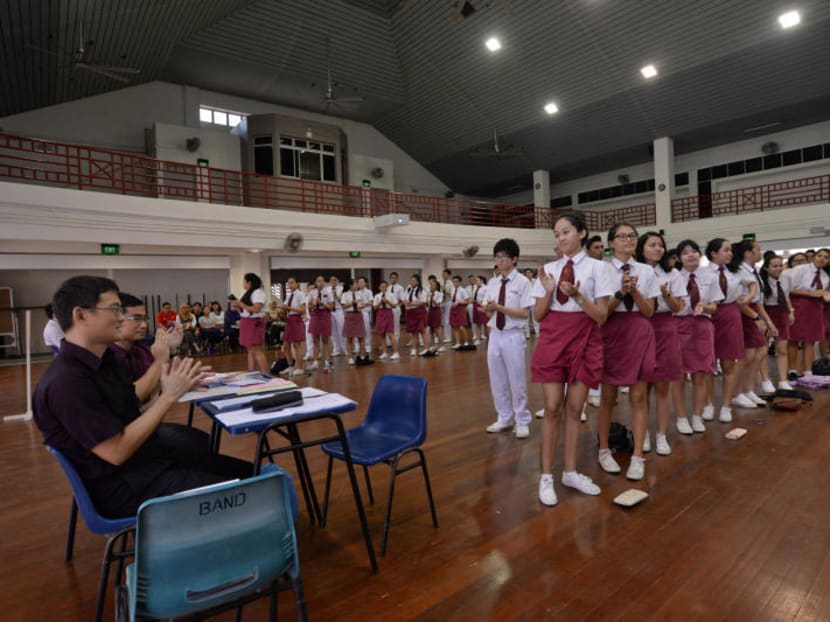Falling cohort will see 22 secondary schools merged into 11
SINGAPORE — Amid falling student cohort sizes, 22 secondary schools — including some household names — will be merged into 11 by 2018 in the largest such merging exercise in the past five years.

Students of Damai Secondary School, one of 11 pairs of secondary schools that will be merged in the next two years. Photo: Robin Choo/TODAY
SINGAPORE — Amid falling student cohort sizes, 22 secondary schools — including some household names — will be merged into 11 by 2018 in the largest such merging exercise in the past five years.
Shrinking birth rates in Singapore over the past two decades have led to a corresponding decline in overall demand for school places and a “significant excess” of secondary school places at the national level, the Ministry of Education (MOE) said on Friday (March 4).
Like other schools merged previously, these schools, located in mature estates islandwide, have smaller cohorts: Among them are seven schools that did not receive any Secondary One students this year because of insufficient demand.
“Sufficient critical mass is needed for a school to offer a good range of educational programmes and co-curricular activities for its students,” said the MOE, adding that schools with low enrolment will find it challenging to offer a holistic range of educational programmes.
The exercise will begin with seven pairs of schools merging from January next year. From January 2018, eight more schools will merge into four.
During a media briefing, the MOE said the Republic has seen Secondary One cohort sizes shrink by 12 per cent — or about 5,000 students — over the past few years, with a “fairly sharp drop” in the past three years. And in the past decade, the number of students entering Secondary One has fallen 20 per cent from 50,000 in 2006 to 38,000 in 2016.
The MOE also noted that birth spikes for each successive “dragon year” had dipped. The Republic saw 42,000 live births in 2012, the most recent Year of the Dragon, down from 47,000 in 2000.
While decisions to merge schools are a “clear manifestation of changing demographics”, they are carefully considered over several years, the ministry said. “We track them for a while before making these decisions … We don’t want to unnecessarily cause any distress to students (and) teachers until we have made a firm decision,” said an MOE spokesperson.
Beyond 2018, the MOE said mergers may continue but not on such a “massive” scale. While the number of schools to be closed because of mergers is largely in line with the fall in enrolment, the ministry noted that “birth rates fluctuate, so we cannot overdo it as well. We need to maintain some buffer”.
Schools identified for merger typically have lower enrolment or are located in mature estates with a small or decreasing student population, among other factors.
Each secondary school here is typically equipped with capacity for seven to eight classes of 40 students enrolling each year. Schools that consistently take in three or fewer classes of Secondary One students are “clearly not sustainable”.
The ministry said it would work with the schools to ensure a smooth transition. The history and heritage of the schools will be documented in a heritage space in the merged premises, it said.
New principals for the schools to be merged next year will be identified by the first half of the year. They will then consult staff on how best to “synergise and optimise” programmes from both schools and decide on a suitable name for the merged institution. Current staff members from each pair of schools can indicate their option to remain in the merged school or be posted elsewhere.
The premises of schools that are not used for the merged student population may be kept as holding sites for other going upgrading or returned to the state, said the MOE.
Pupil-teacher ratios in most schools are set to improve with lower enrolment numbers. However, this may not translate to smaller class sizes across the board, said the MOE.
Over the years, a large part of the improvement in pupil-teacher ratio has been invested in specific programmes, such as those targeted at lower primary students struggling with numeracy and literacy, or classes in the Normal Technical stream in secondary schools.
“Generally, we believe in giving additional teacher resources towards targeted groups for levelling up … This is the best pay-off for us. We are not going for a general reduction in class sizes,” said an MOE spokesperson.
AFFECTED SCHOOLS
Schools to merge from Jan 2017
Balestier Hill Secondary and Beatty Secondary
Henderson Secondary and Bukit Merah Secondary
MacPherson Secondary and Broadrick Secondary
North View Secondary and Northland Secondary
Pioneer Secondary and Boon Lay Secondary
Siglap Secondary and Coral Secondary
Si Ling Secondary and Marsiling Secondary.
Schools to merge from Jan 2018
Bedok North Secondary and Damai Secondary
Bishan Park Secondary and Peirce Secondary
Chong Boon Secondary and Yio Chu Kang Secondary
Greenview Secondary and Loyang Secondary.






